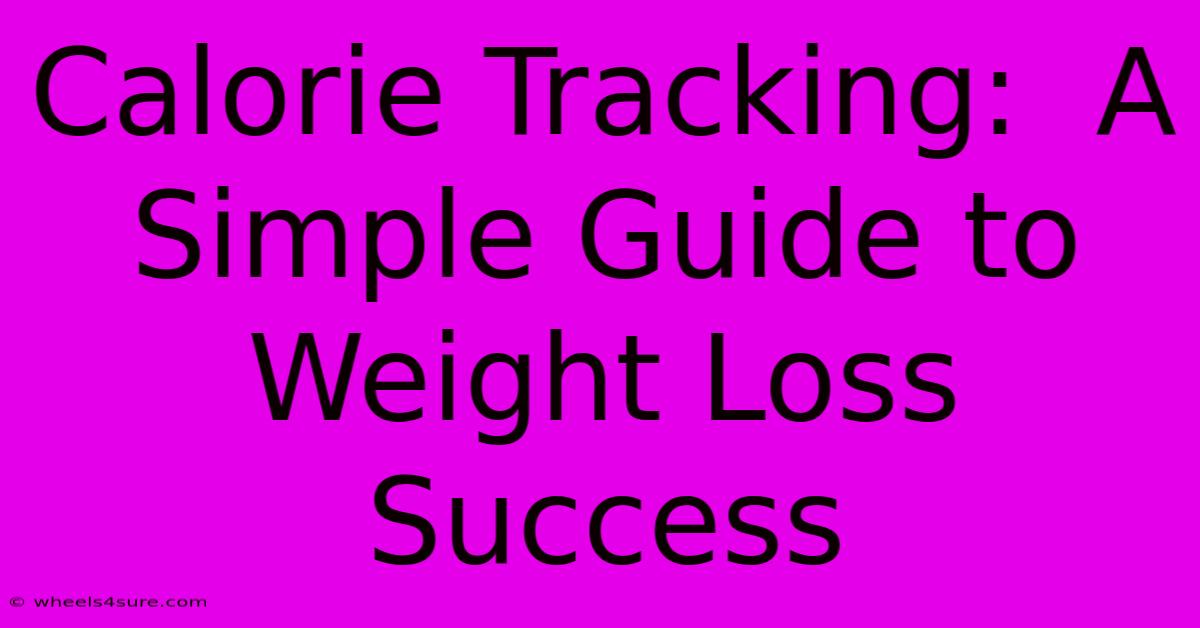Calorie Tracking: A Simple Guide To Weight Loss Success

Table of Contents
Calorie Tracking: A Simple Guide to Weight Loss Success
Losing weight can feel like a monumental task, but it doesn't have to be. One of the most effective, yet surprisingly simple, strategies is calorie tracking. This guide will walk you through everything you need to know to successfully incorporate calorie tracking into your weight loss journey.
Understanding the Basics of Calorie Tracking
At its core, calorie tracking is about monitoring the number of calories you consume versus the number you burn. To lose weight, you need to create a calorie deficit, meaning you burn more calories than you consume. This deficit forces your body to tap into stored fat for energy, resulting in weight loss.
How Many Calories Should I Consume?
Determining your ideal daily calorie intake requires considering several factors:
- Your Basal Metabolic Rate (BMR): This is the number of calories your body burns at rest. Online calculators can estimate your BMR based on your age, sex, height, and weight.
- Your Activity Level: Your calorie needs increase with physical activity. Consider your daily routine, including exercise, work, and leisure activities.
- Your Weight Loss Goal: A moderate weight loss of 1-2 pounds per week generally requires a deficit of 500-1000 calories per day.
Important Note: It's always best to consult a doctor or registered dietitian before making significant changes to your diet, especially if you have any underlying health conditions. They can help you determine a safe and effective calorie target for your individual needs.
Effective Calorie Tracking Methods
There are numerous tools and methods available to track your calorie intake:
1. Calorie Counting Apps:
Many user-friendly apps, like MyFitnessPal, Lose It!, and Cronometer, simplify the process. These apps often feature extensive food databases, barcode scanning, and progress tracking features. They can also help you log your exercise to account for calories burned.
2. Food Journals:
The old-fashioned method of keeping a handwritten food journal can be surprisingly effective. This requires diligent record-keeping but can offer a more mindful approach to eating.
3. Calorie Tracking Websites:
Several websites offer similar functionality to apps, providing tools to log food and track progress.
Beyond the Numbers: Making Calorie Tracking Sustainable
While accurately counting calories is crucial, it’s equally important to make calorie tracking a sustainable habit. Here are some tips:
- Focus on Whole Foods: Prioritize nutrient-dense foods like fruits, vegetables, lean proteins, and whole grains. These foods are generally lower in calories and higher in nutrients, keeping you feeling full and satisfied.
- Don't Deprive Yourself: Allow for occasional treats in moderation. Strict dietary restrictions often lead to unsustainable habits.
- Practice Mindful Eating: Pay attention to your hunger and fullness cues. Avoid distractions while eating and savor your food.
- Stay Hydrated: Drinking plenty of water can help you feel full and reduce calorie intake.
- Get Enough Sleep: Sleep deprivation can disrupt hormones that regulate appetite and metabolism.
- Manage Stress: Stress can lead to overeating. Find healthy ways to manage stress, such as exercise, meditation, or spending time in nature.
Incorporating Exercise into Your Plan
Regular physical activity is crucial for overall health and weight management. Exercise not only burns calories but also improves metabolism, builds muscle mass, and boosts mood. Combine calorie tracking with a regular exercise routine for optimal results. Remember to consult your doctor before starting any new exercise program.
Calorie Tracking: A Long-Term Strategy
Calorie tracking isn't a quick fix; it's a tool to help you understand your eating habits and make informed choices. By combining accurate tracking with a healthy lifestyle, you'll be well on your way to achieving your weight loss goals and maintaining a healthier weight long-term. Remember, consistency and patience are key to success! Don't get discouraged by occasional setbacks; view them as learning opportunities and adjust your strategy as needed. With the right approach, calorie tracking can empower you to take control of your health and achieve lasting results.

Thank you for visiting our website wich cover about Calorie Tracking: A Simple Guide To Weight Loss Success. We hope the information provided has been useful to you. Feel free to contact us if you have any questions or need further assistance. See you next time and dont miss to bookmark.
Featured Posts
-
Shruti Haasan Balancing Family And Fame
Apr 12, 2025
-
Jackson Wang Age Surprisingly Younger Older Than You Think
Apr 12, 2025
-
T Pains Net Worth An Unexpected Number
Apr 12, 2025
-
Birthday Card For A Wonderful Dad Share Your Joy
Apr 12, 2025
-
Eat Your Way To A Healthier You Que Son Las Calorias
Apr 12, 2025
